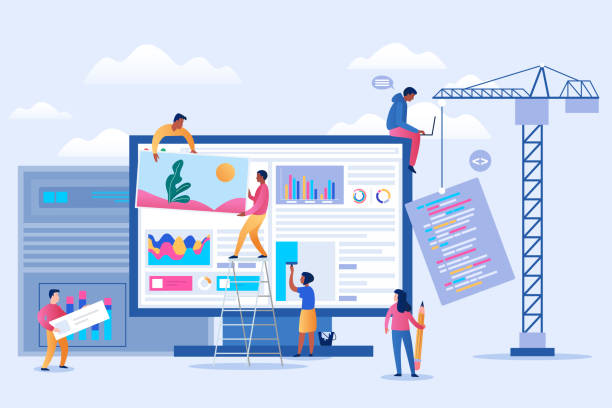The Importance of Website Speed in Today’s Digital World

In the current era where every second is vital, fast website design is more than a luxury feature; it’s a necessity for any business that wants to compete in the online space.
Today’s internet users have very little patience and expect websites to load in a fraction of a second.
#Website_speed not only directly impacts user experience (UX) but is also a crucial factor in #SEO ranking and success in attracting organic traffic.
A slow website can lead to a high Bounce Rate, a decrease in Conversion Rate, and ultimately the loss of potential customers.
Imagine a potential customer has visited your website to purchase a product; if the product page loads with a delay, they will most likely leave your site and go to your competitors.
This is a bitter yet vital reality: every millisecond of delay can mean lost revenue. For this reason, investing in website optimization for speed is a strategic and smart decision.
Fast website design means using optimized code, compressed images, and robust infrastructure to ensure users can access the information they need without any interruption.
This is not only beneficial for users but also highly important for search engines like Google, which display faster websites higher in their results.
Therefore, if you are looking to increase visitors, improve customer experience, and ultimately grow your business, pay special attention to your website’s speed.
This is the first step in fast website design.
Is your current website converting visitors into customers or driving them away? Solve this problem forever with professional corporate website design by Rasawweb!
✅ Build strong credibility and branding
✅ Attract target customers and increase sales
⚡ Get a free consultation now!
Key Factors Affecting Website Loading Speed
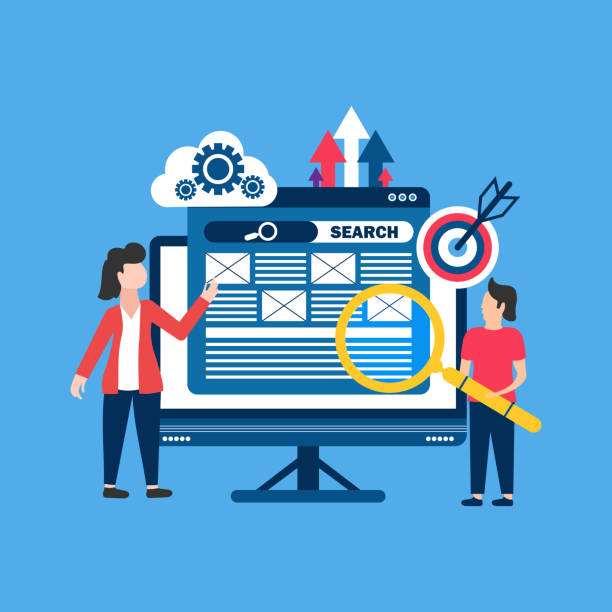
To achieve fast website design, it’s essential to understand the factors affecting loading speed.
These factors include technical and content aspects, each of which can have a significant impact on the overall website performance.
The first factor is hosting quality. A weak host with limited resources, even with the most optimized coding, cannot provide the necessary speed.
Choosing a powerful and optimized hosting service for your website’s needs is a fundamental step towards increasing website speed.
The second factor is optimizing codes and scripts.
Using compressed JavaScript and CSS codes and removing redundant and unused codes helps reduce page size and, consequently, faster loading.
GZIP compression is also an effective technique for reducing the size of files sent from the server to the browser.
The third vital factor is optimizing images and media. High-volume images are among the most common reasons for website slowness.
Using optimized formats (such as WebP), compressing images without significant quality loss, and implementing Lazy Load for images can have a tremendous impact on speed.
Also, the number of HTTP requests to the server is important; the fewer these requests, the faster the website loads.
This can be achieved by combining CSS and JS files and using Sprite Images.
Finally, using Content Delivery Networks (CDN) can significantly improve loading speed for users in different geographical locations.
By considering and optimizing these factors, you can achieve a fast and efficient website design that provides an excellent user experience and contributes to your online business success.
Optimizing Images and Media for Speed Improvement
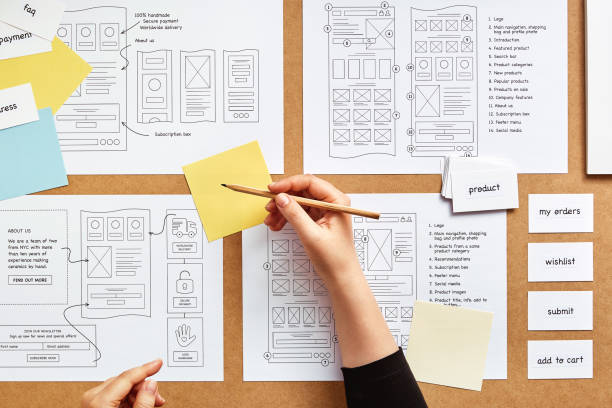
One of the biggest obstacles to fast website design is high-volume images and media files.
These files can significantly increase page loading times and disrupt the user experience.
To overcome this challenge, image optimization is a vital step. The first step is choosing the right image format.
Formats like WebP are a better choice for the web than JPEG or PNG due to higher compression and quality retention.
Although not all browsers support WebP, a Fallback approach can be used.
The second step is image compression.
Many online and offline tools can reduce image size without a noticeable loss in quality.
The important point is to compress images with appropriate dimensions for web display; there is no need to upload an image with 4000 pixels for display in a 200-pixel box.
This only imposes extra bulk on your website.
The third solution is using Lazy Load.
With this feature, images and videos are only loaded when the user scrolls to the relevant section on the page, not during the initial page load.
This is particularly effective for long pages with a lot of image content and contributes to fast website design.
Also, using alt tags for images is not only beneficial for SEO but also provides information to the user if the image fails to load.
For videos, it’s better to use platforms like YouTube or Vimeo for hosting and embed the video on your site to reduce your server load.
By applying these techniques, you can ensure that your images and media become a factor in fast website design instead of an obstacle.
In the following, you will see a table comparing common image formats for the web:
| Format | Primary Use Cases | Advantages | Disadvantages |
|---|---|---|---|
| JPEG | Real photos, high-detail images | High compression, wide support | Quality loss, no transparency support |
| PNG | Vector graphics, logos, images with transparency | High quality, full transparency support | Large file size for real photos |
| WebP | Alternative to JPEG and PNG for web | Excellent compression, supports transparency and animation | Relatively newer support (but expanding) |
| SVG | Icons, logos, vector graphics | Scalability without quality loss, very small file size | Only for vector graphics, not real photos |
The Role of Hosting and CDN in Fast Website Design
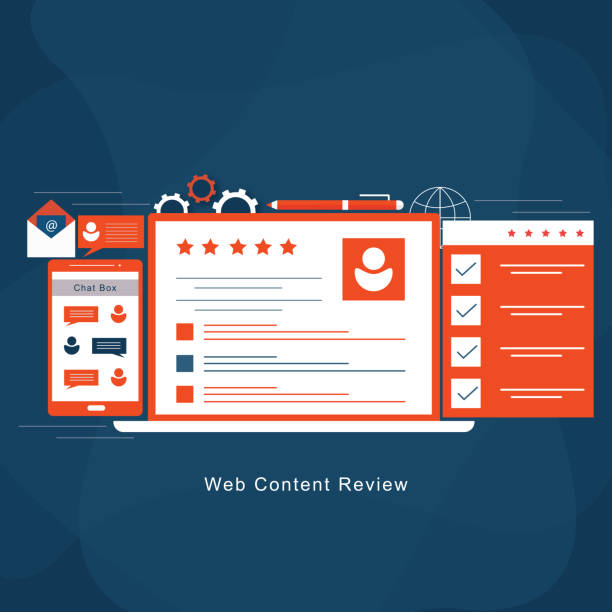
Choosing suitable hosting and using CDN (Content Delivery Network) are two fundamental factors in fast website design.
Hosting serves as a home for your website, and the quality of this home directly impacts page loading speed.
An inexpensive Shared host might be good to start, but with increasing traffic, you might experience slowness and disruptions.
VPS or Dedicated hosts offer more dedicated resources, which in turn leads to higher stability and speed.
Important factors in choosing a host include server location (proximity to your audience), dedicated RAM and CPU, storage type (SSD instead of HDD), and bandwidth.
The closer the server is to your audience, the lower the Latency and the faster information is exchanged.
This is particularly important for international websites.
Here, the role of CDN becomes prominent.
A CDN is a network of servers scattered across various geographical locations worldwide.
When a user visits your website, the CDN delivers static content (such as images, CSS, and JavaScript) from the server closest to that user.
This significantly reduces loading time because all requests do not need to be sent to your website’s main server in a distant location.
Using a CDN, especially for websites with a global audience, is an excellent solution for increasing web speed.
Cloudflare and Akamai are examples of popular CDNs.
By combining powerful and suitable hosting with a CDN, you can provide a solid infrastructure for fast website design that delivers a seamless user experience and significantly helps improve your website’s SEO ranking.
Tired of your e-commerce website not generating as much revenue as it could? Rasawweb is your answer! With our specialized professional e-commerce website design services, we solve this problem forever!
✅ Increase sales rate and revenue
✅ High loading speed and unparalleled user experience
⚡ Get a free e-commerce website design consultation
The Importance of Optimized Coding and File Compression
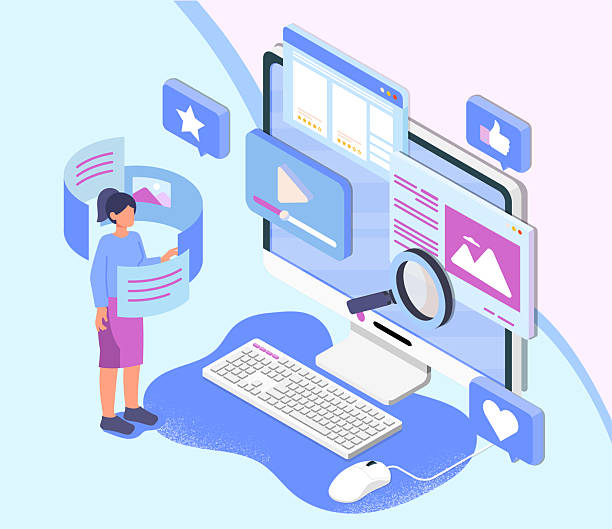
One of the main pillars in achieving fast website design is optimized coding and efficient file compression.
Large CSS, JavaScript, and HTML files can significantly slow down website loading speed.
The first step in this regard is code minification. Minification means removing whitespace, newlines, comments, and any other unnecessary characters from code files that are not essential for program functionality but increase file size.
This significantly reduces the size of files sent from the server to the user’s browser.
For example, a JavaScript file that is several kilobytes without minification can be reduced to half or even less after minification.
The second point is file concatenation (or combining files).
In the past, combining multiple CSS or JavaScript files into a single file was common to reduce HTTP requests.
Although this need has diminished with the advent of HTTP/2 and HTTP/3, it can still be beneficial in some scenarios.
The third aspect is optimizing JavaScript and CSS codes. Identify and remove unused code.
Many themes and plugins load code that is not needed on all pages of the site.
By using analysis and plugin management tools, you can identify these extra codes and conditionalize their loading.
Also, using CSS Sprites to combine multiple small images into a single large image file can reduce the number of HTTP requests for icon images.
Using asynchronous loading techniques for JavaScript also ensures that script loading does not block the loading of the rest of the page content, contributing to fast website design.
Finally, enabling GZIP compression on the server is also essential, as it significantly reduces the size of text files (HTML, CSS, JS) before sending them to the browser.
By implementing these techniques, you can significantly improve your website’s loading speed and achieve a fast website design.
Website Speed Testing Tools and Result Interpretation
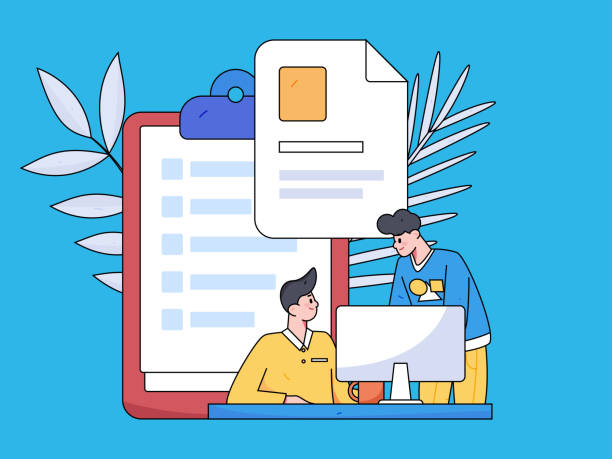
After implementing fast website design methods, it is essential to periodically evaluate your website’s performance.
Website speed testing tools help you identify your website’s strengths and weaknesses and find areas for improvement.
The most famous tool in this field is Google PageSpeed Insights. This tool assigns a score from 0 to 100 to your website and provides suggestions for improvement, including image optimization, CSS and JS compression, and leveraging browser caching.
Another very popular tool is GTmetrix.
GTmetrix also provides a score for your website’s performance and structure and displays a comprehensive report of full page load time, number of requests, and details of each request.
This tool is very useful for deeper analysis and precise problem identification.
WebPageTest.org is also an advanced tool that allows speed testing from different geographical locations and with various browsers, providing very detailed Waterfall Chart information for each request.
When using these tools, don’t just focus on the final score; pay attention to the recommendations and details of each report.
Interpreting these results is crucial for continuous site improvement. For example, if Google PageSpeed Insights suggests optimizing images, look for large images.
If it tells you to leverage browser caching, enable the relevant caching settings on your server or CMS.
The ultimate goal of using these tools is not merely to achieve a high score, but to truly improve user experience and achieve a fast and smooth website design.
These tools provide you with a roadmap for fast and optimized website design and help ensure your site is always performing at its best.
The Impact of Loading Speed on User Experience (UX) and Conversion Rate

Website loading speed is not just a technical factor; it has a direct impact on User Experience (UX) and, ultimately, Conversion Rate.
In fact, fast website design is closely linked to your online business success.
Today’s users are more impatient than ever; studies show that most users expect a website to load in less than 2 to 3 seconds.
If your website is slower than this, there’s a high probability that the user will leave it before the page fully loads.
This phenomenon is known as a high ‘Bounce Rate’.
A high bounce rate not only indicates a poor user experience but can also send a negative signal to search engines. When users quickly leave a site, Google might assume that your site lacks relevant or useful content, which can affect your SEO ranking.
On the other hand, a fast-loading site increases user satisfaction.
Users can quickly access the information they need, navigate between pages without delay, and have a positive experience interacting with your brand.
This positive experience directly impacts the conversion rate.
For example, in an online store, if the purchasing process (adding to cart, payment) is fast and smooth, the probability of the customer completing the purchase will be significantly higher.
This means more revenue for your business.
For this reason, fast website design is a strategic investment with a significant return.
Improving website speed can lead to increased user engagement, reduced bounce rate, increased time on site, and ultimately, growth in conversion rate.
Therefore, if you are looking for success in the digital world, do not underestimate the importance of website loading speed.
In the following, you will see the impact of website speed on various factors in a table:
| Indicator | Impact of High Speed | Impact of Low Speed |
|---|---|---|
| User Experience (UX) | Positive, increased satisfaction | Negative, user frustration |
| Bounce Rate | Significant decrease | Sharp increase |
| Conversion Rate | Significant increase | Noticeable decrease |
| SEO Ranking | Improvement and enhancement | Decrease and drop |
| Average Session Duration | Increase | Decrease |
Responsive Design and Speed on Mobile Devices
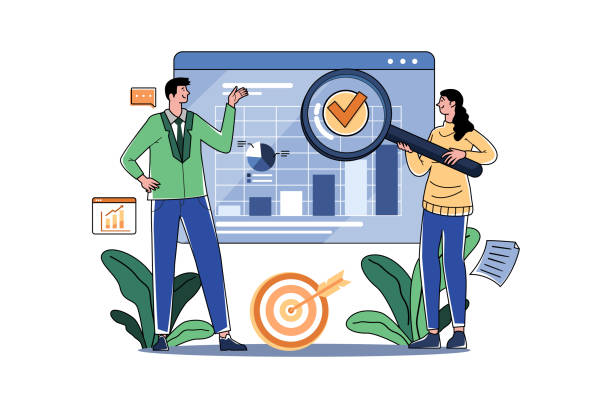
In today’s world, where a significant portion of internet traffic occurs via mobile devices, responsive design and fast website design on mobile are intertwined.
A website that loads quickly on desktop will not necessarily be fast on mobile, unless specific optimizations have been made for it.
Responsive design means that your website automatically adjusts to the screen dimensions of the user’s device, whether it’s a mobile phone, tablet, or desktop.
This not only provides a better visual experience but also helps with fast website design on mobile in various ways.
Since mobile users often use the internet at slower speeds (such as 3G or 4G), page size becomes more critical for them.
Mobile-optimized images, fewer and more optimized CSS and JavaScript codes, and the use of low-volume web fonts all contribute to improving speed on mobile.
Google, with the introduction of Mobile-First Indexing, places special emphasis on the importance of website performance on mobile devices.
This means that Google, for ranking websites, first examines their mobile version.
Therefore, if your site is slow on mobile, even if it’s fast on desktop, your SEO ranking might suffer.
Technologies like AMP (Accelerated Mobile Pages) have also been developed with the goal of creating very fast web pages for mobile and can help with instant content loading.
Investing in fast and responsive website design for mobile is no longer an option but a necessity for competing and attracting a wide audience.
This approach ensures that your website performs optimally on any device and provides a seamless user experience.
Are you losing potential customers due to an unprofessional website? Rasawweb is your answer! With our specialized corporate website design services:
✅ Enhance your business’s credibility and standing
✅ Experience attracting more targeted customers
⚡ Act now to receive a free consultation!
Advanced Challenges and Solutions in Fast Website Design

While the basic principles of fast website design are relatively clear, there are also more complex challenges and advanced solutions for maximum speed optimization.
One of these challenges is server resource management and caching. Caching means storing versions of web pages or static files in the user’s browser or on the server for faster access on subsequent visits.
Effective caching can significantly reduce server load and increase loading speed for returning visitors.
Caching types include Browser Caching, Server Caching, and Object Caching, each playing a significant role in accelerating websites.
Another challenge is Initial Rendering.
How can one ensure that the main content of the site is displayed quickly to the user, even if all resources haven’t loaded? Techniques like Server-Side Rendering (SSR) or Static Site Generation (SSG) can be helpful in this regard.
SSR means rendering the page on the server and sending complete HTML to the browser, which allows the user to see the content faster.
SSG also generates HTML pages before a user request and keeps them ready for delivery.
Web fonts can also be a challenge for speed. Loading too many fonts or high-volume fonts can slow down the speed.
Using optimized font formats (like WOFF2), asynchronously loading fonts, and employing the Font-Display: Swap property to prevent “Flash of Unstyled Text” (FOUT) are important solutions.
Also, managing HTTP requests and eliminating unnecessary or duplicate requests, especially API requests, plays a crucial role in fast website design.
By addressing these advanced challenges and utilizing specialized solutions, the highest level of website performance and speed can be achieved, resulting in an exceptional user experience and sustainable online success.
The Future of Fast Website Design and Emerging Trends

The web world is constantly evolving, and with the emergence of new technologies, the concept of fast website design also undergoes change and evolution.
Emerging trends in this field focus more on deeper optimizations, intelligence, and advanced user experience. One of the most important of these trends is the broader use of Artificial Intelligence (AI) and Machine Learning in website optimization.
These technologies can analyze traffic patterns and user behavior and automatically apply settings to improve speed; for example, predicting which resources a user might need and preloading them.
The second trend is the evolution of web standards and network protocols.
HTTP/3, as the next generation of the HTTP protocol, promises unparalleled speeds by reducing latency and improving packet loss management, which will significantly impact fast website design.
WebAssembly is another technology that enables near-native performance code execution in the browser and can help develop more complex web applications at higher speeds.
Another trend gaining importance is optimization for smart devices and the Internet of Things (IoT). With the proliferation of connected devices, websites must be able to deliver their content quickly and optimally for these platforms as well.
The future of fast website design is moving towards a fully personalized and intelligent web where content is dynamically rendered and delivered based on the user’s real-time needs.
These approaches not only improve speed but also elevate the user experience to an unprecedented level, enabling websites to achieve stability and success in today’s highly competitive online environment.
Therefore, anticipating and preparing for these trends is essential for every developer and business owner.
Frequently Asked Questions
| Row | Question | Answer |
|---|---|---|
| 1 | What does fast website design mean? | Fast website design means optimizing website design and development processes so that the final result (website) is ready for use in the shortest possible time, while maintaining quality and efficiency. This includes using efficient tools, templates, and techniques. |
| 2 | Why is speed important in website design? | Speed in website design is important because clients usually have an immediate need for an online presence. Additionally, longer projects can be more costly and delay business opportunities. Delivering websites faster contributes to client satisfaction and competitive advantage. |
| 3 | What tools help with fast website design? | Content Management Systems (CMS) like WordPress, Joomla, or Drupal, the use of CSS frameworks like Bootstrap or Tailwind CSS, Page Builders like Elementor or Visual Composer, and Rapid Application Development (RAD) tools help with fast design. |
| 4 | Does using ready-made templates affect fast design? | Yes, using ready-made and standard templates has a very significant impact on fast design. These templates are pre-designed and only require customization of content, color schemes, and images, which drastically reduces development time. |
| 5 | What is the role of CMS (Content Management System) in fast website design? | CMSs play a key role in accelerating the website design and development process due to offering a graphical user interface, eliminating the need for deep coding for most operations, the availability of ready-made plugins and templates, and easy content editing capabilities. |
| 6 | Does high design speed reduce the final website quality? | Not necessarily. If standard and optimized methods, tools, and templates are used, a high-quality website can be designed in a short time. The knowledge and experience of the design team are also very effective in maintaining quality. |
| 7 | What tips are important for accelerating client communication in website design? | Having a clear and defined process for requirements gathering, using standard forms for content submission, setting realistic deadlines, and holding focused and efficient meetings can accelerate client communication. |
| 8 | What effect does image optimization have on website loading speed after design? | Image optimization (volume compression, using suitable formats like WebP) reduces the overall size of website pages. This reduction in size helps browsers download and display pages faster, which improves user experience. |
| 9 | Is suitable hosting effective on the final website speed after design? | Yes, high-quality hosting, powerful servers, sufficient resources, and adequate bandwidth play a very important role in website loading speed after design. Even an optimized website will perform slowly on a weak host. |
| 10 | For what types of businesses is fast website design most suitable? | Fast website design is highly suitable for small and medium-sized businesses, startups, nascent online stores, bloggers, or individuals who need an immediate and low-cost online presence. This method allows them to enter the market faster and receive feedback. |
And other services of Rasawweb Advertising Agency in the field of advertising
Smart Advertising Campaign: A creative platform for improving campaign management using real data.
Smart Brand Identity: A combination of creativity and technology to increase sales through precise audience targeting.
Smart Advertising Campaign: A novel service for enhancing customer behavior analysis through precise audience targeting.
Smart Direct Marketing: A creative platform for improving online growth with intelligent data analysis.
Smart SEO: Revolutionize customer behavior analysis with the help of precise audience targeting.
And over a hundred other services in the field of internet advertising, advertising consultation, and organizational solutions
Internet Advertising | Advertising Strategy | Advertorial
Sources
- The Importance of Website Speed in Web Design
- How to Optimize Your Website Speed?
- Benefits of a Fast Loading Website
- Website Speed Optimization Guide
Are you ready to transform your business in the digital world? Rasawweb Afarin Digital Marketing Agency, with expertise in custom website design, targeted SEO, and innovative digital marketing strategies, will be your guide on the path to online success.
📍 Tehran, Mirdamad Street, next to Bank Markazi, Kazeroun Jonoubi Alley, Ramin Alley, No. 6

